简单聊一下Android音频通路的切换
Android支持多种设备的的输出。一台正常的机子,本身就自带话筒,扬声器,麦克风等多个声音输入输出设备,再加上五花八门的外置设备(通过耳机,蓝牙,wifi等方式连接),使声音的输出更具多样性。Android支持如此多的设备连接,那么android内部是怎样对设备的输出输出进行控制的呢?这一次我们主要来看看音频通路的切换。
音频流、设备、音频策略
stream_type:音频流的类型。在当前系统中,Android(6.0)一共定义了11种stream_type以供开发者使用。Android上层开发要想要发出声音,都必须先确定当前当前的音频类型。
content_type:具体输出类型。虽然当前一共有11种stream_type,但一旦进入到Attribute,Android就只将其整理成几种类型。这才是实际的类型。
device:音频输入输出设备。Android定义了多种设备输入输出设备(具体物理设备可能还是那几个,但是输出场景不尽相同)。
routing_strategy:音频路由策略。默认情况下,Android是根据路由策略去选择设备负责输出输入音频的。
stream_type在android中java层与c++层均有定义。并且对应的值是保持一致的。
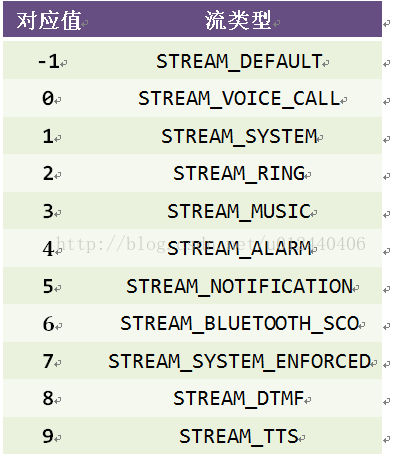
device与stream_type一样,在java层和C++层均有定义,并且会根据使用的情况不同蕴含多个定义:

相对stream_type,routing_strategy只是一个定义在RountingStrategy.h的一个简单的枚举结构体:
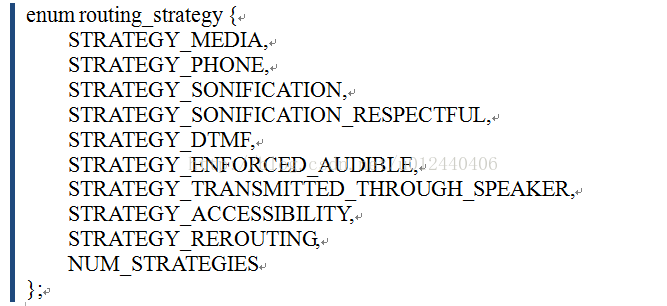
usecase只是qcom内部定义的一个数据结构,位于hal层,用作处理处理内部声卡逻辑和输出方案。输出方案与声卡中的mixer_path_xxx.xml相联。而mixer_path等相关文件,才是具体的音频输出方案。

我们通过查看当前的声卡情况确定了当前具体的mixer_path文件——mixer_path_skue.xml。xml文件内部就是我们预定义的usecase的具体情况:

在mixer_path类文件中,一个标准的path就如上面的红框那样。有名字,有一定的参数。另外,一个patch之中,还可以嵌套另外一个patch。
由于usecase只是目前高通hal层独有的定义,所以本文不会花太多时间和精力去探讨usecase的相关设置和内容。目前来说,对这个有一定的认知就可。
AudioPolicy和AudioPolicyService
在了解完Audio一些基本的定义设定之后,我们来看一下Android的Audio整体架构。Audio内部系统从上到下包含各方面的东西。对于声音输出的设备的选择与切换,我们主要需要关注2个地方。第一处,是外接设备如耳机,蓝牙设备等连接的通知。第二处就是Audio系统中核心的AudioFinger与AudioPolicyService的处理内容。
AudioFinger是Audio系统的工作引擎,管理者系统中输入输出音频流,并承担音频数据混音,以及读写Audio硬件等工作以实现数据的输入输出功能。AudioPolicyService是Audio系统策略控制中心,具体负责掌管系统中声音设备的选择和切换,音量控制等功能。
AudioFinger与AudioPolicyService的类图关系:
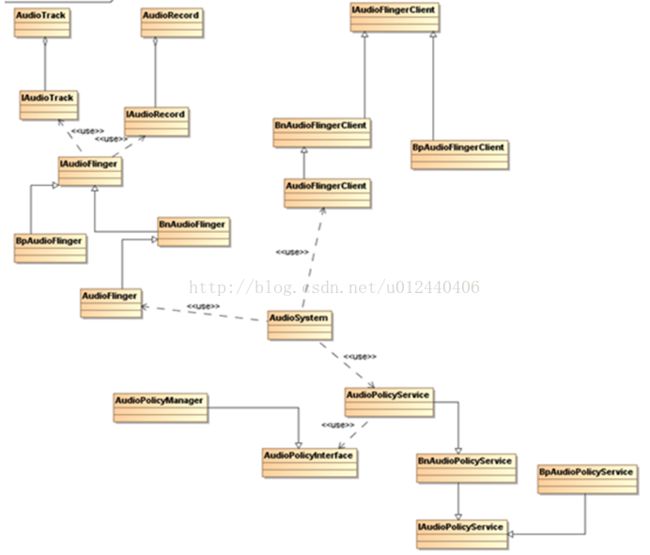
在AudioFlinger和AudioPolicyService的运作中其实包含着很多类,但同时,我们也可以发现,在Audio系统中, AudioFinger与AudioPolicyService是紧密相连的。总得来说,AudioFinger与AudioPolicyService是Audio系统的核心。所以下面我们很多内容的主角,都是他们2个。
基本的声音输出调用
发出声音是Android机器的一个最基本的功能。但是,Android是怎么发出声音的呢?就算不连接外设,Android最基本还有听筒和扬声器2个设备。那么,Android内部,是怎么控制他们2个发出声音的呢?下面我们来具体看 一下Android一般情况下发出声音时选择设备的过程。
我们要想分析Android中的声音输出,当然是先通过播放音频去一步一步了解Android是怎恶魔输出声音的。下面我们以一个最简单的AudioTrack播放音频为例,来看下Android的发生过程。
一个简单的AudioTrack播放的例子如下:
AudioTrack audioTrack = new AudioTrack(AudioManager.STREAM_MUSIC, 11025/2,
AudioFormat.CHANNEL_CONFIGURATION_MONO,
AudioFormat.ENCODING_PCM_16BIT,
audioLength, AudioTrack.MODE_STREAM);
audioTrack.play();
audioTrack.write(audioData, 0, sizeInBytes);
AudioTrack在接收参数创建的时候,就会将设置的steamtype保存在对应的AudioAttributes当中(AudioAttributes是一个描述关于音频流的信息的属性集合的类)。
我们知道,在android系统中,系统封装的对象是一层一层往下调用的。所以,在我们创建了一个java的AudioTrack对象的时候,其实在同时,在C++当中,我们已经做了很多操作了。下面我们来看一下,AudioTrack对象创建时,主要做了什么:
static jint
android_media_AudioTrack_setup(JNIEnv *env, jobject thiz, jobject weak_this,
jobject jaa,
jint sampleRateInHertz, jint channelPositionMask, jint channelIndexMask,
jint audioFormat, jint buffSizeInBytes, jint memoryMode, jintArray jSession) {
//……
// create the native AudioTrack object
sp lpTrack = new AudioTrack();
//……
// initialize the native AudioTrack object
status_t status = NO_ERROR;
switch (memoryMode) {
case MODE_STREAM:
status = lpTrack->set(
AUDIO_STREAM_DEFAULT,
sampleRateInHertz,
format,
nativeChannelMask,
frameCount,
AUDIO_OUTPUT_FLAG_NONE,
audioCallback, &(lpJniStorage->mCallbackData),
0,
0,
true,
sessionId,
AudioTrack::TRANSFER_SYNC,
NULL,
-1, -1,
paa);
break;
//……
if (status != NO_ERROR) {
ALOGE("Error %d initializing AudioTrack", status);
goto native_init_failure;
}
// save our newly created C++ AudioTrack in the "nativeTrackInJavaObj" field
// of the Java object (in mNativeTrackInJavaObj)
setAudioTrack(env, thiz, lpTrack);
//……
}
从上面的代码可以看出,在创建java层的AudioTrack对象时,对应的jni也创建出一个C++的AudioTrack对象,并且传入了部分参数和调用了其方法。
接下来我们来看看C++的AudioTrack对象的构造方法:
AudioTrack::AudioTrack()
: mStatus(NO_INIT),
mIsTimed(false),
mPreviousPriority(ANDROID_PRIORITY_NORMAL),
mPreviousSchedulingGroup(SP_DEFAULT),
mPausedPosition(0),
mSelectedDeviceId(AUDIO_PORT_HANDLE_NONE),
mPlaybackRateSet(false)
{
mAttributes.content_type = AUDIO_CONTENT_TYPE_UNKNOWN;
mAttributes.usage = AUDIO_USAGE_UNKNOWN;
mAttributes.flags = 0x0;
strcpy(mAttributes.tags, "");
}我们再回到上面,发现jni层在创建完AudioTrack对象后,根据memoryMode的不同而进行了不同的AudioTrack->set()操作,只是因为AudioTrack提供2种不同的输出方式(对内存的影响和要求不同)。我来看看看set中主要的操作:
status_t AudioTrack::set(…){
//……
status_t status = createTrack_l();
if (status != NO_ERROR) {
if (mAudioTrackThread != 0) {
mAudioTrackThread->requestExit(); // see comment in AudioTrack.h
mAudioTrackThread->requestExitAndWait();
mAudioTrackThread.clear();
}
return status;
//……
}在AudioTrack的set()中,除了部分的参数判断和设置之外,我们可以看到,他调用了自身的createTrack_l()进行了进一步的设置。
status_t AudioTrack::createTrack_l()
{
const sp& audioFlinger = AudioSystem::get_audio_flinger();
if (audioFlinger == 0) {
ALOGE("Could not get audioflinger");
return NO_INIT;
}
audio_io_handle_t output;
audio_stream_type_t streamType = mStreamType;
audio_attributes_t *attr = (mStreamType == AUDIO_STREAM_DEFAULT) ? &mAttributes : NULL;
//……
audio_offload_info_t tOffloadInfo = AUDIO_INFO_INITIALIZER;
if (mPlaybackRateSet == true && mOffloadInfo == NULL && mFormat == AUDIO_FORMAT_PCM_16_BIT) {
mOffloadInfo = &tOffloadInfo;
}
status_t status = AudioSystem::getOutputForAttr(attr, &output,
(audio_session_t)mSessionId, &streamType, mClientUid,
mSampleRate, mFormat, mChannelMask,
mFlags, mSelectedDeviceId, mOffloadInfo);
//……
IAudioFlinger::track_flags_t trackFlags = IAudioFlinger::TRACK_DEFAULT;
//……
sp track = audioFlinger->createTrack(streamType,
mSampleRate,
mFormat,
mChannelMask,
&temp,
&trackFlags,
mSharedBuffer,
output,
tid,
&mSessionId,
mClientUid,
&status);
//……
上面的代码可以看出,AudioTrack从这里开始,与AudioFlinger等进行大量的交互:获取句柄,获取输出,创建IAudioTrack指针对象等等。所以接下来,就是AudioFlinger的相关内容了。在这里,我们先简单总结下AudioTrack的创建过程:
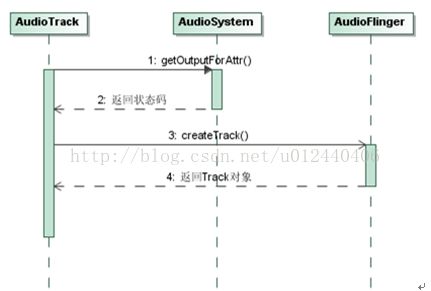
根据AudioTrack的性质,Java层在创建完成AudioTrack对象直接调用play()和write()操作,那么其实从另一方面我们可以猜想,在Java层创建完成AudioTrack之后,系统已经设置好输出的设备等等操作,只等调用play()和write方法进行播放。所以为了验证我们的猜想,接下来针对AudioFlinger&AudioSystem的相关具体分析验证。
AudioFlinger&AudioPolicyService的控制过程
回到上面的内容,我们可以看到,AudioTrack在调用createTrack_l()的方法的时候,开始通过AudioSystem获取output。所以下面我们来看看AudioSystem的getOutputForAttr():
status_t AudioSystem::getOutputForAttr()
{
const sp& aps = AudioSystem::get_audio_policy_service();
if (aps == 0) return NO_INIT;
return aps->getOutputForAttr(attr, output, session, stream, uid,
samplingRate, format, channelMask,
flags, selectedDeviceId, offloadInfo);
} 从上面我们可以看到,AudioSystem只是作为一个过渡,然后通过获取AudioPolicyService的句柄去getOutputForAttr()。我们继续跟踪AudioPolicyService的情况,会发现其实他只是在AudioPolicyService中也只是作为一个过渡,真正进行getOutputForAttr()的,在AudioPolicyManager之中。
status_t AudioPolicyManager::getOutputForAttr()
{
//……
*stream = streamTypefromAttributesInt(&attributes);
sp deviceDesc;
for (size_t i = 0; i < mAvailableOutputDevices.size(); i++) {
if (mAvailableOutputDevices[i]->getId() == selectedDeviceId) {
deviceDesc = mAvailableOutputDevices[i];
break;
}
}
mOutputRoutes.addRoute(session, *stream, SessionRoute::SOURCE_TYPE_NA, deviceDesc, uid);
//根据strategy获取device
routing_strategy strategy = (routing_strategy) getStrategyForAttr(&attributes);
audio_devices_t device = getDeviceForStrategy(strategy, false /*fromCache*/);
if ((attributes.flags & AUDIO_FLAG_HW_AV_SYNC) != 0) {
flags = (audio_output_flags_t)(flags | AUDIO_OUTPUT_FLAG_HW_AV_SYNC);
}
*output = getOutputForDevice(device, session, *stream,
samplingRate, format, channelMask,
flags, offloadInfo);
//……
在AudioPolicyManager的getOutputForAttr()中,我们可以发现关键点在strategy的获取与device的获取当中。而在这当中,关键的参数恰恰是在先前从java层一步一步封装的过来的attributes。我们先来简单看一下attributes这个参数的数据结构:

从audio_attributes_t的结构我们可以看出,audio_attributes_t保存着需要输出音频的应用的相关配置信息。
然后,根据刚刚的代码,我们来了解一下strategy的获取:uint32_t AudioPolicyManager::getStrategyForAttr(const audio_attributes_t *attr) {
// flags to strategy mapping
if ((attr->flags & AUDIO_FLAG_BEACON) == AUDIO_FLAG_BEACON) {
return (uint32_t) STRATEGY_TRANSMITTED_THROUGH_SPEAKER;
}
if ((attr->flags & AUDIO_FLAG_AUDIBILITY_ENFORCED) == AUDIO_FLAG_AUDIBILITY_ENFORCED) {
return (uint32_t) STRATEGY_ENFORCED_AUDIBLE;
}
// usage to strategy mapping
return static_cast(mEngine->getStrategyForUsage(attr->usage));
虽然在这里,会先对flags参数进行比较,但是,在实际上flags大部分时候都是0。所以最后,都是根据“mEngine->getStrategyForUsage(attr->usage)”去选择StrategyForUsage。当然,再到下一步就到了就是switch和case的过程,这里就不继续展开了。
在获取到strategy之后,我们来看看Audio接着是怎么来确定device的。
先继续看AudioPolicyManager的getDeviceForStrategy():
audio_devices_t AudioPolicyManager::getDeviceForStrategy(routing_strategy strategy,
bool fromCache)
{
// Routing
// see if we have an explicit route
// scan the whole RouteMap, for each entry, convert the stream type to a strategy
// (getStrategy(stream)).
// if the strategy from the stream type in the RouteMap is the same as the argument above,
// and activity count is non-zero
// the device = the device from the descriptor in the RouteMap, and exit.
for (size_t routeIndex = 0; routeIndex < mOutputRoutes.size(); routeIndex++) {
sp route = mOutputRoutes.valueAt(routeIndex);
routing_strategy strat = getStrategy(route->mStreamType);
bool strategyMatch = (strat == strategy) ||
((strategy == STRATEGY_ACCESSIBILITY) &&
((mEngine->getStrategyForUsage(
AUDIO_USAGE_ASSISTANCE_ACCESSIBILITY) == strat) ||
(strat == STRATEGY_MEDIA)));
if (strategyMatch && route->isActive()) {
return route->mDeviceDescriptor->type();
}
}
if (fromCache) {
ALOGVV("getDeviceForStrategy() from cache strategy %d, device %x",
strategy, mDeviceForStrategy[strategy]);
return mDeviceForStrategy[strategy];
}
return mEngine->getDeviceForStrategy(strategy);
}
调用AudioPolicyManager的getDeviceForStrategy()的时候,一般会先查下一下当前的RouteMap,看看有没有匹配的情况的。但由于我们新申请一个output的时候,传入的参数是false,所以这个时候,是会直接通过mEngine去直接获取device。
而在mEngine中,getDeviceForStrategy()又是一堆的选择判断,然后返回设备:
audio_devices_t Engine::getDeviceForStrategy(routing_strategy strategy) const
{
const DeviceVector &availableOutputDevices = mApmObserver->getAvailableOutputDevices();
const DeviceVector &availableInputDevices = mApmObserver->getAvailableInputDevices();
const SwAudioOutputCollection &outputs = mApmObserver->getOutputs();
uint32_t device = AUDIO_DEVICE_NONE;
uint32_t availableOutputDevicesType = availableOutputDevices.types();
switch (strategy) {
//……
case STRATEGY_MEDIA: {
uint32_t device2 = AUDIO_DEVICE_NONE;
if (isInCall() && (device == AUDIO_DEVICE_NONE)) {
// when in call, get the device for Phone strategy
device = getDeviceForStrategy(STRATEGY_PHONE);
break;
}
if (strategy != STRATEGY_SONIFICATION) {
// no sonification on remote submix (e.g. WFD)
if (availableOutputDevices.getDevice(AUDIO_DEVICE_OUT_REMOTE_SUBMIX, String8("0")) != 0) {
device2 = availableOutputDevices.types() & AUDIO_DEVICE_OUT_REMOTE_SUBMIX;
}
}
if (isInCall() && (strategy == STRATEGY_MEDIA)) {
device = getDeviceForStrategy(STRATEGY_PHONE);
break;
}
if ((device2 == AUDIO_DEVICE_NONE) &&
(mForceUse[AUDIO_POLICY_FORCE_FOR_MEDIA] != AUDIO_POLICY_FORCE_NO_BT_A2DP) &&
(outputs.getA2dpOutput() != 0)) {
device2 = availableOutputDevicesType & AUDIO_DEVICE_OUT_BLUETOOTH_A2DP;
if (device2 == AUDIO_DEVICE_NONE) {
device2 = availableOutputDevicesType & AUDIO_DEVICE_OUT_BLUETOOTH_A2DP_HEADPHONES;
}
//……
ALOGVV("getDeviceForStrategy() strategy %d, device %x", strategy, device);
return device;
}
我们就其中一个strategty(STRATEGY_MEDIA)来具体看看Audio系统的选择输出设备:
1) 首先我们会获取当前存在的设备集合availableOutputDevices
2) 然后根据传入的strategty类型进行匹配选择
3) 在选择之前会先检测是否处于特殊情况下(如通话中)
4) 最后按照优先级匹配设备。
然后就这样,选择设备的流程就此结束。简单来说,选择设备的流程,主要是几个参数一步一步去确定然后最后确定合适的设备。具体选择设备的简单流程如图:
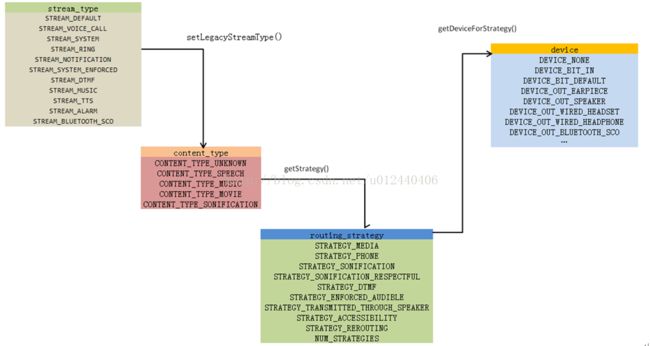
针对音频通路的切换,我们就简单聊到这里。谢谢。